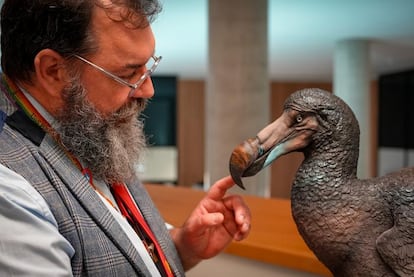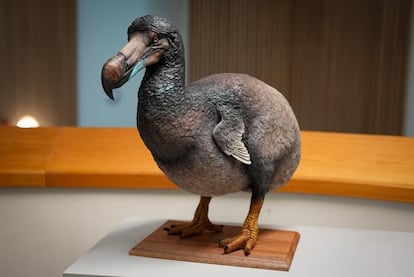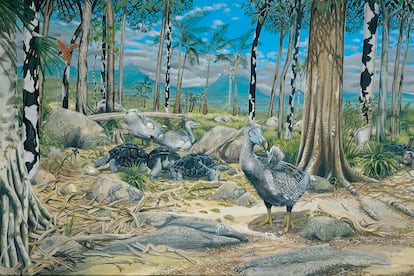The dodo was not fat and clumsy: Study debunks the image we have of the most famous extinct bird
British researchers have begun a project to recreate the anatomy and behavior of this species. The flightless animal is a symbol of extinctions caused by humans, as well as a creature largely unknown to science

Perhaps the dodo wouldn’t be so well-known today if Lewis Carroll hadn’t included it as a character in Alice’s Adventures in Wonderland (1865). The flightless bird’s popularity was further amplified by Disney almost a century later.
It’s said that Carroll incorporated the bird as a caricature of himself, since a stutter caused him to pronounce his real surname as “Do-Do-Dodgson.” And it’s difficult to know to what extent we must credit Carroll and Disney for the image we have of the dodo, as a plump and clumsy bird… fodder for extinction.
However, a recent study suggests that this ridiculous and friendly image is, in fact, false. It means that the depiction is yet another outrage committed against the dodos by humans, after exterminating them more than 300 years ago and having incorrectly classified them in the field of science.
The dodo — or Raphus cucullatus — has gone down in history as the best-known symbol of extinctions caused by humans. The first written reference about the bird comes from Dutch sailors in 1598, although Mauritius — the only place where it lived — was previously visited by Arab and Portuguese ships. The latter may have coined its name from doudo (“crazy,” in Portuguese), although it may also come from the Dutch word dodaars (“fat bottom”), or it may have been onomatopoeia, referring to its call.
The origin of its name is an example of how much we don’t know about the dodo. The bird’s familiar image may suggest that it was well known to science before it went extinct. However, this isn’t the case. “At the time of its discovery, no one was really very interested in the animal. The dodo became popular after it went extinct,” says Neil Gostling, an evolutionary biologist at the University of Southampton in the United Kingdom. He’s the supervisor of the recent study into the species.
Although live and stuffed animals were transported to Europe and Asia, almost everything was lost. By the end of the 18th century, only a mummified head and foot remained, along with some bones. The dodo had been history for more than a century: many of the bones preserved today were obtained after its extinction. “Before we knew what we had, it was gone,” Gostling sighs.
A fast and active bird
The image we have of the dodo doesn’t do it justice, either. Although numerous drawings exist, the vast majority were copied from earlier ones, or from stuffed specimens. Mark Young — the study’s first author, also from the University of Southampton — said: “We don’t have much of an idea of the dodo or what it looked like; the only drawings from [real] life were made by Dutch sailors, who saw it in Mauritius.” The idea of the fat, lazy bird may, therefore, have been due to sailors fattening the creatures up for the long voyage to Europe.

Many birds also naturally fatten up before the breeding season. This appears to have been the case with the dodo and its sister species, the Rodrigues solitaire (Pezophaps solitaria), another flightless bird that became extinct in the mid-18th century. It lived on the island of the same name, about 350 miles from Mauritius. “Its shape probably varied throughout the year,” Young notes.
Gostling says that Dutchman Joris Joostensz Laerle’s sketches from 1601 — the only ones drawn based on living dodos in Mauritius — “also show a large rump, but the bird is seen to be much more upright, with an almost athletic pose.” This fits with more contemporary descriptions of the dodo as a fast, active bird. Far from the image of a squat, clumsy animal, powerful tendons in its legs propelled it at high speed through the forests where it lived. The bird was able to move at a high speed, even climbing rocky hills.
Giant pigeons
The work of Young, Gostling and their co-authors — published in the Zoological Journal of the Linnaean Society — puts the evolutionary lineage of the dodo and the Rodrigues solitaire in order. It clarifies the taxonomic hodgepodge that entangled their classification and led to the researchers’ predecessors proposing several species, such as the white dodo, the Nazarene dodo, or the white solitaire.
Reviewing 400 years of scientific literature and the preserved remains — the head and foot are kept in the Oxford University Museum of Natural History — the researchers reconfirm the belonging of these birds (unique species in their respective genera) to the family of the Columbidae (pigeons and doves), but twinned within a smaller group exclusive to them: the Subtribe Raphina.

The work of these scientists has only just begun. The multidisciplinary team formed by the University of Southampton and the Oxford University Museum of Natural History also involves paleoartists, as well as experts in computational biomechanics. Together, they’re recreating — as faithfully as possible — the anatomy of the dodo. It’s as close as they can get to bringing the iconic species back to life.
With its annihilation, human beings destroyed an entire branch of the tree of life — the giant terrestrial cousins of the pigeons. Dodos survived for millions of years, until humans crossed their path. Scientists hope that the lessons learned will prevent us from making the same mistakes again. In the words of Young, “back in the 17th century, there was no such concept of ‘extinction’ like we have today. The scientific term still hadn’t been coined, while the natural philosophers of that time were Christians who believed in God and his creation.” Back then, it was inconceivable that humans could eliminate a species — created by God — from the face of the Earth.
The author of the new study adds that scientists didn’t travel to Mauritius, either. They merely examined the logs of Dutch sailors and the samples they brought back to Europe.
According to Gostling, because of the dodo’s strange appearance, many people came to question its existence, believing it to be a mythical animal, like the phoenix. But in the meantime, hunting, deforestation and predators — introduced by Europeans — wiped out the flightless bird, which, for millions of years, had never needed to flee for its life. The last confirmed sighting of a dodo dates back to 1662. “Unfortunately, humanity wiped out the dodo in less than 100 years from first contact,” Young laments.
Sign up for our weekly newsletter to get more English-language news coverage from EL PAÍS USA Edition
Tu suscripción se está usando en otro dispositivo
¿Quieres añadir otro usuario a tu suscripción?
Si continúas leyendo en este dispositivo, no se podrá leer en el otro.
FlechaTu suscripción se está usando en otro dispositivo y solo puedes acceder a EL PAÍS desde un dispositivo a la vez.
Si quieres compartir tu cuenta, cambia tu suscripción a la modalidad Premium, así podrás añadir otro usuario. Cada uno accederá con su propia cuenta de email, lo que os permitirá personalizar vuestra experiencia en EL PAÍS.
¿Tienes una suscripción de empresa? Accede aquí para contratar más cuentas.
En el caso de no saber quién está usando tu cuenta, te recomendamos cambiar tu contraseña aquí.
Si decides continuar compartiendo tu cuenta, este mensaje se mostrará en tu dispositivo y en el de la otra persona que está usando tu cuenta de forma indefinida, afectando a tu experiencia de lectura. Puedes consultar aquí los términos y condiciones de la suscripción digital.
More information
Últimas noticias
NASA discovers Titan doesn’t have an ocean, but a ‘slushy ice layer’ that increases possibility of life
Innocence lost in the forest of the child soldiers: ‘Each leader of the armed group had his girls’
‘Fallout’ or how the world’s largest company turned an anti-capitalist apocalyptic Western into a phenomenon
From inflation to defending migrants: Eileen Higgins and Zohran Mamdani inaugurate the new Democratic resistance against Trump
Most viewed
- ‘El Limones’ and the growing union disguise of Mexican organized crime
- Christian Louboutin: ‘Young people don’t want to be like their parents. And if their parents wear sneakers, they’re going to look for something else’
- The low-cost creative revolution: How technology is making art accessible to everyone
- ‘We are dying’: Cuba sinks into a health crisis amid medicine shortages and misdiagnosis
- Liset Menéndez de la Prida, neuroscientist: ‘It’s not normal to constantly seek pleasure; it’s important to be bored, to be calm’









































